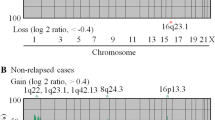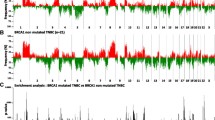Abstract
We analysed chromosome 16q in 106 breast cancers using tiling-path array-comparative genomic hybridization (aCGH). About 80% of ductal cancers (IDCs) and all lobular cancers (ILCs) lost at least part of 16q. Grade I (GI) IDCs and ILCs often lost the whole chromosome arm. Grade II (GII) and grade III (GIII) IDCs showed less frequent whole-arm loss, but often had complex changes, typically small regions of gain together with larger regions of loss. The boundaries of gains/losses tended to cluster, common sites being 54.5–55.5 Mb and 57.4–58.8 Mb. Overall, the peak frequency of loss (83% cancers) occurred at 61.9–62.9 Mb. We also found several ‘minimal’ regions of loss/gain. However, no mutations in candidate genes (TRADD, CDH5, CDH8 and CDH11) were detected. Cluster analysis based on copy number changes identified a large group of cancers that had lost most of 16q, and two smaller groups (one with few changes, one with a tendency to show copy number gain). Although all morphological types occurred in each cluster group, IDCs (especially GII/GIII) were relatively overrepresented in the smaller groups. Cluster groups were not independently associated with survival. Use of tiling-path aCGH prompted re-evaluation of the hypothetical pathways of breast carcinogenesis. ILCs have the simplest changes on 16q and probably diverge from the IDC lineage close to the stage of 16q loss. Higher-grade IDCs probably develop from low-grade lesions in most cases, but there remains evidence that some GII/GIII IDCs arise without a GI precursor.






Similar content being viewed by others
References
Barnes DM, Millis RR, Gillett CE, Ryder K, Skilton D, Fentiman IS et al. (2004). Endocr Relat Cancer 11: 85–96.
Berx G, Cleton-Jansen AM, Nollet F, de Leeuw WJ, van de Vijver M, Cornelisse C et al. (1995). EMBO J 14: 6107–6115.
Berx G, Cleton-Jansen AM, Strumane K, de Leeuw WJ, Nollet F, van Roy F et al. (1996). Oncogene 13: 1919–1925.
Buerger H, Otterbach F, Simon R, Schafer KL, Poremba C, Diallo R et al. (1999). J Pathol 189: 521–526.
Cleton-Jansen AM . (2002). Breast Cancer Res 4: 5–8.
Cleton-Jansen AM, Buerger H, Haar N, Philippo K, van de Vijver MJ, Boecker W et al. (2004). Genes Chromosomes Cancer 41: 109–116.
Cleton-Jansen AM, Callen DF, Seshadri R, Goldup S, McCallum B, Crawford J et al. (2001). Cancer Res 61: 1171–1177.
Cleton-Jansen AM, Moerland EW, Pronk JC, van Berkel CG, Apostolou S, Crawford J et al. (1999). Br J Cancer 79: 1049–1052.
Cooper LS, Gillett CE, Patel NK, Barnes DM, Fentiman IS . (1999). Cancer 86: 2053–2058.
Crawford J, Ianzano L, Savino M, Whitmore S, Cleton-Jansen AM, Settasatian C et al. (1999). Genomics 56: 90–97.
Devilee P, Cleton-Jansen AM, Cornelisse CJ . (2001). Trends Genet 17: 569–573.
Dorion-Bonnet F, Mautalen S, Hostein I, Longy M . (1995). Genes Chromosomes Cancer 14: 171–181.
Douglas EJ, Fiegler H, Rowan A, Halford S, Bicknell DC, Bodmer W et al. (2004). Cancer Res 64: 4817–4825.
Droufakou S, Deshmane V, Roylance R, Hanby A, Tomlinson I, Hart IR . (2001). Int J Cancer 92: 404–408.
Elston CW, Ellis IO . (1991). Histopathology 19: 403–410.
Fiegler H, Carr P, Douglas EJ, Burford DC, Hunt S, Scott CE et al. (2003). Genes Chromosomes Cancer 36: 361–374.
Frengen E, Rocca-Serra P, Shaposhnikov S, Taine L, Thorsen J, Bepoldin C et al. (2000). Genomics 70: 273–285.
Hwang ES, Nyante SJ, Yi Chen Y, Moore D, DeVries S, Korkola JE et al. (2004). Cancer 100: 2562–2572.
Jain AN, Tokuyasu TA, Snijders AM, Segraves R, Albertson DG, Pinkel D . (2002). Genome Res 12: 325–332.
Kern SE . (2002). Cancer Biol Ther 1: 571–581.
Korsching E, Packeisen J, Helms MW, Kersting C, Voss R, van Diest PJ et al. (2004). Br J Cancer 90: 1422–1428.
Millis RR, Barnes DM, Lampejo OT, Egan MK, Smith P . (1998). Eur J Cancer 34: 548–553.
Nishizaki T, Chew K, Chu L, Isola J, Kallioniemi A, Weidner N et al. (1997). Int J Cancer 74: 513–517.
Pandis N, Idvall I, Bardi G, Jin Y, Gorunova L, Mertens F et al. (1996). Int J Cancer 66: 191–196.
Quon KC, Berns A . (2001). Genes Dev 15: 2917–2921.
Roylance R, Droufakou S, Gorman P, Gillett C, Hart IR, Hanby A et al. (2003). J Pathol 200: 53–58.
Roylance R, Gorman P, Hanby A, Tomlinson I . (2002). J Pathol 196: 32–36.
Roylance R, Gorman P, Harris W, Liebmann R, Barnes D, Hanby A et al. (1999). Cancer Res 59: 1433–1436.
Santarosa M, Ashworth A . (2004). Biochim Biophys Acta 1654: 105–122.
Sharp AJ, Locke DP, McGrath SD, Cheng Z, Bailey JA, Vallente RU et al. (2005). Am J Hum Genet 77: 78–88.
Tomlinson IP, Lambros MB, Roylance RR . (2002). Genes Chromosomes Cancer 34: 349–353.
Tsuda H, Callen DF, Fukutomi T, Nakamura Y, Hirohashi S . (1994). Cancer Res 54: 513–517.
Watson JE, Doggett NA, Albertson DG, Andaya A, Chinnaiyan A, van Dekken H et al. (2004). Oncogene 23: 3487–3494.
Whitmore SA, Crawford J, Apostolou S, Eyre H, Baker E, Lower KM et al. (1998). Genomics 50: 1–8.
Acknowledgements
We are very grateful to colleagues at the Sanger Institute Microarray Facility for array printing.
Author information
Authors and Affiliations
Corresponding author
Rights and permissions
About this article
Cite this article
Roylance, R., Gorman, P., Papior, T. et al. A comprehensive study of chromosome 16q in invasive ductal and lobular breast carcinoma using array CGH. Oncogene 25, 6544–6553 (2006). https://doi.org/10.1038/sj.onc.1209659
Received:
Revised:
Accepted:
Published:
Issue Date:
DOI: https://doi.org/10.1038/sj.onc.1209659
- Springer Nature Limited
Keywords
This article is cited by
-
ATBF1 is a potential diagnostic marker of histological grade and functions via WNT5A in breast cancer
BMC Cancer (2022)
-
Mixed ductal–lobular carcinoma: an analysis of CDH1 DNA copy number variation and mutation
Breast Cancer (2021)
-
Significant random signatures reveals new biomarker for breast cancer
BMC Medical Genomics (2019)
-
Role of columnar cell lesions in breast carcinogenesis: analysis of chromosome 16 copy number changes by multiplex ligation-dependent probe amplification
Modern Pathology (2018)
-
Invasive lobular carcinoma of the breast: morphology, biomarkers and ’omics
Breast Cancer Research (2015)




